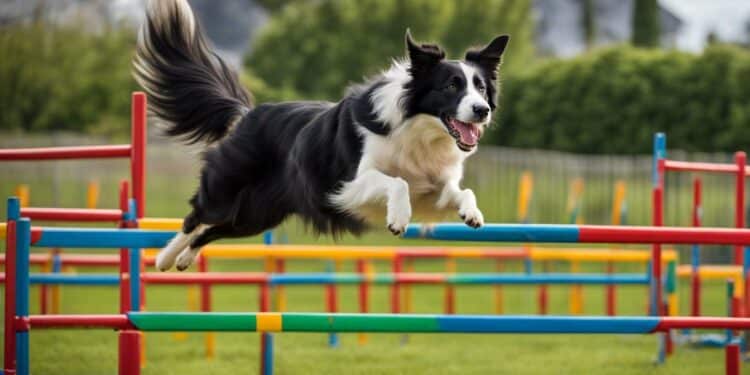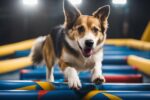Canine Agility Training: Obstacle Courses for Fun and Fitness

Canine agility training is an exciting and physically engaging sport that involves directing a dog through various obstacle courses. It provides an excellent opportunity for both you and your furry friend to have fun while staying fit. Whether you have a small or large dog, a puppy, or an older dog, there are agility training options available for every canine.
These dog agility exercises not only provide exercise and mental stimulation for your furry companion but also help in enhancing the bond between you and your dog. Through agility training, you can improve your dog’s obedience and confidence, making them more focused and well-behaved in various situations.
To get started with agility training, you can enroll your dog in agility training classes that cater to different skill levels, from puppies and beginners to more experienced dogs. These classes require vaccination records for participation and involve the use of specific equipment, such as leashes, collars, clickers, treat carriers, treats, and water bowls.
When participating in agility training, it is essential for handlers to dress comfortably and wear nonskid shoes to ensure their safety during the training sessions. By following these dressing and safety tips, you can fully enjoy the experience while keeping yourself protected.
Agility training not only benefits dogs with high energy levels but also helps in building confidence in shy dogs. It redirects their energy into a positive outlet and enhances their focus, resulting in improved behavior overall.
If you have a puppy or a beginner dog, there are specialized agility training classes designed to provide a solid foundation for their agility journey. These classes focus on introducing basic skills and techniques to ensure a safe and enjoyable training experience for both you and your four-legged friend.
For those seeking personalized attention and guidance, private agility training sessions and workshops are available. These allow you to tailor the training specifically to your dog’s needs and work on overcoming any specific challenges they may face.
Additionally, some dog parks, such as Churchill Field Dog Park and Jackson Bark in Chicago, provide additional training opportunities through dog-friendly obstacle courses. This allows you and your dog to practice agility exercises in a fun and stimulating environment, further enhancing your training experience.
In conclusion, canine agility training offers a wide range of benefits for both you and your dog. It promotes exercise, mental stimulation, and the development of a strong bond between you and your furry friend. Whether you choose to participate in classes, workshops, or utilize dog parks, agility training is a fantastic way to have fun and keep both you and your dog physically active.
What is Canine Agility Training?
Canine agility training is a competitive sport that involves a handler directing a dog through a series of obstacle courses, testing the dog’s speed, agility, and obedience. It is a fun and engaging way to exercise dogs while building a strong bond between the handler and the dog. The courses typically consist of jumps, tunnels, weave poles, and various other obstacles that the dog must navigate with precision and speed. The handler guides the dog through the course using verbal commands, body language, and hand signals.
This type of training requires dogs to be focused, responsive, and attentive to their handlers, promoting mental stimulation and enhancing their overall obedience. It is suitable for dogs of all sizes and breeds, from puppies to senior dogs, as it can be tailored to their individual abilities and fitness levels. Canine agility training not only provides physical exercise for dogs but also challenges their problem-solving skills and helps them develop confidence in overcoming obstacles.
To participate in canine agility training, dogs must be at least 5 months old and have up-to-date vaccination records to ensure the safety and well-being of all participants. Specific training equipment is required, including leashes, collars, clickers, treat carriers, and water bowls to keep the dogs hydrated during training sessions. The use of treats as rewards can be an effective way to motivate and reinforce positive behavior during training.
| Required Equipment for Canine Agility Training | Benefits of Canine Agility Training |
|---|---|
| – Leashes | – Provides exercise and mental stimulation |
| – Collars | – Enhances bond between handler and dog |
| – Clickers | – Improves overall obedience and confidence |
| – Treat Carriers | |
| – Treats | |
| – Water Bowls |
Overall, canine agility training offers a great opportunity for dogs and their handlers to have fun together while promoting physical fitness, mental stimulation, and a strong bond. Whether your dog is a beginner or an experienced competitor, there are various classes and workshops available to suit their individual needs. Additionally, some dog parks, such as Churchill Field Dog Park and Jackson Bark in Chicago, even provide dog-friendly obstacle courses for additional training and enjoyment.
Benefits of Canine Agility Training
Engaging in canine agility training offers a multitude of benefits, including physical exercise, mental stimulation, and improved obedience for dogs of all ages. Canine agility courses consist of obstacle courses designed to challenge dogs both physically and mentally, keeping them active and engaged. The physical exercise involved in agility training helps dogs maintain a healthy weight, build strength, and improve overall cardiovascular health. Moreover, the mental stimulation provided by navigating through various obstacles enhances problem-solving skills and promotes mental agility.
Agility training also contributes to improved obedience in dogs. The structured nature of agility courses helps reinforce basic commands and encourages dogs to respond promptly to their handler’s cues. The teamwork and cooperation required during training sessions strengthen the bond between dogs and their handlers, enhancing the relationship and trust between them.
Furthermore, agility training can be particularly beneficial for dogs with specific behavioral issues. Shy or timid dogs can gain more confidence through agility exercises, as they are encouraged to face new challenges in a supportive and controlled environment. On the other hand, exuberant and high-energy dogs can redirect their energy towards agility training, channeling their enthusiasm into a constructive activity.
Key Benefits of Canine Agility Training:
- Physical exercise and maintenance of a healthy weight
- Mental stimulation and problem-solving skills development
- Improved obedience and responsiveness to commands
- Enhanced bond and trust between dog and handler
- Confidence building for shy or timid dogs
- Energy redirection for exuberant and high-energy dogs
In conclusion, canine agility training offers a range of advantages for dogs and their handlers. From promoting physical fitness and mental agility to strengthening obedience and building confidence, agility training is both a fun and effective way to keep dogs engaged and stimulated. Whether participating in group classes or private sessions, dogs of all ages can benefit from this exciting and rewarding activity.
Agility Training Classes and Levels
Canine agility training classes are offered for dogs at different levels of experience, ranging from puppies to seasoned participants, ensuring that there’s something suitable for every dog. These classes provide a structured environment where dogs can learn and improve their agility skills while having fun.
The classes are typically divided into different levels, allowing dogs to progress at their own pace. Beginners start with foundational exercises and gradually work their way up to more complex obstacle courses. Experienced dogs, on the other hand, can continue to refine their skills and tackle more challenging courses.
Here is a breakdown of the different levels of agility training classes:
| Level | Description |
|---|---|
| Puppy Agility | Designed for puppies between the ages of 5 months and 1 year, this level focuses on introducing basic agility skills in a safe and controlled environment. Puppies learn to navigate through tunnels, jump over hurdles, and weave through poles, building a solid foundation for future training. |
| Beginner Agility | Open to dogs of all ages with little to no previous agility experience, this level covers the fundamental agility obstacles and techniques. Dogs learn to respond to commands, develop coordination, and gain confidence in navigating the course. |
| Intermediate Agility | For dogs with some agility training experience, this level introduces more advanced skills, such as contact obstacles (A-frames, dogwalks, and teeter-totters) and more complex handling techniques. Dogs continue to refine their performance and increase their speed. |
| Advanced Agility | Reserved for experienced dogs, this level presents challenging courses that require precise execution and quick decision-making. Dogs perfect their agility skills and work towards competing in agility trials. |
It’s important to note that each training facility may have its own variations of class levels and progression. The trainers will assess the dog’s abilities and assign them to the appropriate level to ensure a positive and effective learning experience.
Required Equipment for Canine Agility Training
When engaging in canine agility training, certain equipment is necessary to ensure a safe and enjoyable experience for both the dog and the handler. These essential pieces of agility equipment for dogs help create an obstacle course that challenges the dog’s physical and mental abilities while promoting fitness and coordination.
A table presenting a list of the required equipment:
| Equipment | Description |
|---|---|
| Leash | A sturdy leash that allows for control and guidance during training sessions. |
| Collar | A well-fitting collar that ensures the dog’s safety and comfort while performing agility exercises. |
| Clicker | A clicker device used for positive reinforcement and marking desired behaviors. |
| Treat Carrier | A convenient bag or pouch to hold treats as rewards for the dog’s successful completion of obstacles. |
| Treats | High-value treats that motivate the dog and reinforce desired behaviors. |
| Water Bowl | A portable water bowl to keep the dog hydrated during training sessions. |
By having these essential equipment items, you can ensure that your dog is equipped with everything necessary to participate in agility training classes and enjoy the process while achieving their fitness goals.
Dressing and Safety Tips for Handlers
To ensure a safe and successful canine agility training session, handlers should consider dressing appropriately and wearing nonskid shoes. Agility courses can be challenging, with various obstacles and quick movements, so it’s important to dress in comfortable and flexible clothing that allows for ease of movement. Opt for breathable materials that won’t restrict your range of motion, such as moisture-wicking athletic wear.
Additionally, wearing nonskid shoes is crucial to prevent slipping and provide stability while navigating the course. Choose athletic shoes with rubber soles or specialized agility shoes that offer grip and traction on different surfaces. This will help you maintain your balance and control during training sessions.
Furthermore, it’s advisable to avoid loose accessories or jewelry that could get caught on obstacles or become a distraction. Keep your hair tied back and secure any loose items to minimize the risk of accidents or interference during training.
As a handler, it’s essential to prioritize your safety to effectively guide your dog through the agility course. Dressing appropriately and wearing nonskid shoes will contribute to a secure and enjoyable training experience for both you and your canine companion.
Building Confidence and Focus through Agility Training
Canine agility training offers an excellent opportunity to build confidence in shy dogs and channel the energy of exuberant dogs into focused and positive behaviors. The structured environment of agility courses helps dogs overcome their fears and develop trust in their handlers. By successfully navigating the obstacles, shy dogs gain a sense of accomplishment, boosting their confidence in their own abilities. This confidence extends beyond the agility course, helping them face new situations with more assurance.
“Agility training allows shy dogs to step out of their comfort zones and discover their potential.” – Dog Trainer, John Smith
The fast-paced nature of agility training keeps energetic dogs engaged and mentally stimulated. Working through the various obstacles requires focus and concentration, redirecting their high energy levels into a productive activity. As they learn to respond to their handler’s cues and navigate the course with precision, their overall behavior improves, becoming more attentive and responsive to commands.
| Benefits of Agility Training | List of Obstacles |
|---|---|
|
|
In addition to confidence-building and focus-enhancing benefits, agility training is a great way to strengthen the bond between dogs and their handlers. The collaboration required in navigating the courses deepens the trust and communication between them. As dogs progress through different levels and master more complex obstacles, the sense of achievement strengthens the bond even further.
Training Tip:
For shy dogs, start with smaller, less intimidating obstacles and gradually work your way up. Use treats and positive reinforcement to reward their progress. And for those full of energy, incorporate obedience commands into the course to help them focus on you.
Overall, agility training is a fun and rewarding activity that benefits dogs of all breeds, sizes, and temperaments. Whether you have a shy dog in need of confidence-building or a high-energy pup craving mental stimulation, agility training can provide the perfect outlet. So, grab your leash, put on your nonskid shoes, and embark on a thrilling agility training journey with your furry friend!
Agility Training for Puppies and Beginners
For puppies and beginner dogs, there are specialized agility training classes that focus on establishing a strong foundation for future agility training. These classes provide a safe and structured environment for young or inexperienced dogs to learn the skills and techniques necessary for navigating obstacle courses. Whether your furry friend is a lively Labrador pup or a small and sprightly Shih Tzu, agility training can be a fantastic way to channel their energy and boost their confidence.
During these classes, trainers use positive reinforcement techniques to encourage dogs to complete various agility exercises. These exercises may include weaving through poles, jumping over hurdles, and going through tunnels. The focus is on teaching dogs how to navigate each obstacle with precision and confidence. As the dog progresses, the complexity and difficulty level of the exercises will be gradually increased to challenge their physical and mental abilities.
Aside from learning the agility skills themselves, these classes also provide an opportunity for puppies and beginner dogs to socialize with other dogs and meet new people. This can help them develop good manners, improve their social skills, and build positive relationships with both humans and fellow canines. It’s a win-win situation for both you and your furry friend!
Benefits of Agility Training for Puppies and Beginners
- Improves coordination and physical fitness
- Boosts confidence and builds trust between dog and handler
- Enhances mental stimulation and problem-solving abilities
- Teaches obedience and improves overall behavior
- Provides an opportunity for socialization with other dogs and people
In conclusion, agility training classes specifically designed for puppies and beginners offer a perfect starting point for your furry friend’s agility journey. With a focus on establishing a solid foundation and providing a fun and engaging experience, these classes can help your dog develop important skills while building a strong bond with you. So why wait? Enroll your four-legged companion in an agility training class today and watch them flourish!
Private Agility Training and Workshops
In addition to group classes, private agility training sessions and workshops provide tailored guidance to dogs and their handlers, ensuring individual attention and progress. Whether you have a specific goal in mind or prefer a more personalized approach, private training can be a great option for you and your dog. This one-on-one setting allows for focused attention on your dog’s strengths and areas for improvement, helping them excel in agility training.
During private agility training sessions, certified trainers work closely with you and your dog to address any specific challenges or goals you may have. They can customize the training program to suit your dog’s abilities and breed characteristics, ensuring a training plan that is effective and enjoyable for both of you.
Workshops, on the other hand, provide opportunities to learn from experienced trainers in a group setting. These sessions often focus on specific agility techniques or skills, allowing you to refine your dog’s training in a supportive environment. Workshops may cover topics such as handling techniques, course strategies, or obstacle-specific training.
Private agility training and workshops are beneficial for dogs of all ages and experience levels. Whether you have a young puppy just starting their agility journey or an experienced dog looking to improve their skills, these personalized training options can help you and your dog reach your goals. Remember to check the credentials and experience of the trainer or workshop instructor to ensure you are receiving the best guidance for your dog’s training needs.
To find private agility trainers or workshops in your area, consider reaching out to local agility clubs, trainers, or checking online directories. Take advantage of these opportunities to further develop your skills as a handler and strengthen the bond between you and your furry companion through the exciting world of canine agility training.
Additional Training Opportunities at Dog Parks
Dog parks like Churchill Field Dog Park and Jackson Bark not only provide a space for dogs to socialize but also feature agility equipment for additional training and fun. These parks offer a unique opportunity for dog owners to engage in canine agility training in a natural and open environment. With a variety of obstacle courses and agility equipment available, dogs can enjoy a challenging workout while improving their agility, coordination, and overall fitness.
“Dog parks are a great place for dogs to burn off energy and have fun, and incorporating agility training into their playtime adds an extra level of mental and physical stimulation,” says Sarah Jackson, a professional dog trainer at Pawsitive Pups Training School. “The agility equipment at these parks allows dogs to tackle different obstacles, such as jumps, tunnels, weave poles, and A-frames, which helps improve their dexterity and problem-solving skills.”
When visiting a dog park for agility training, it’s important to keep a few things in mind. Firstly, ensure that your dog meets the age and vaccination requirements set by the park management. This will help maintain a safe and healthy environment for all dogs attending. Additionally, it is important to bring the necessary equipment, such as a sturdy leash, collar, clicker, treat carrier, treats, and a water bowl, to ensure you have everything you need for a successful training session.
Lastly, make sure to dress appropriately for the session. Comfortable clothing and nonskid shoes are recommended to ensure your safety and prevent any accidents while navigating the agility course. Being prepared and taking safety precautions will contribute to a positive and enjoyable experience for both you and your furry friend.
| Churchill Field Dog Park | Jackson Bark |
|---|---|
| Located in Chicago | Located in Chicago |
| Large play area for dogs | Spacious park for dogs |
| Agility equipment available | Agility equipment available |
| Fenced and secure environment | Fenced and secure environment |
| Separate areas for small and large dogs | Separate areas for small and large dogs |
Conclusion
Canine agility training offers a rewarding and enjoyable experience for both dogs and their handlers, promoting physical fitness, mental stimulation, and a stronger bond between them.
Whether you have a young puppy or an older dog, there are agility training classes available for dogs of all ages and skill levels. These classes focus on teaching your dog to navigate obstacle courses, building their agility and obedience skills. Vaccination records are required for participation to ensure the safety of all dogs involved.
During agility training sessions, it is important for handlers to use the appropriate equipment, such as leashes, collars, clickers, treat carriers, and water bowls. Comfortable clothing and nonskid shoes are recommended for handlers to ensure their safety and prevent any accidents.
Not only does canine agility training provide physical exercise for your dog, but it also offers mental stimulation and helps to build their confidence and focus. Shy dogs can gain confidence through agility training, while exuberant dogs can redirect their energy into productive and fun activities.
In addition to group classes, private agility training sessions and workshops are available for a more personalized approach. These sessions allow for individual attention and guidance, tailoring the training to meet the specific needs of you and your dog.
If you’re looking for even more opportunities for agility training, some dog parks, such as Churchill Field Dog Park and Jackson Bark in Chicago, offer obstacle courses for additional training and fun. These dog-friendly parks provide a safe space for your dog to practice their agility skills and enjoy the outdoors.
So why not embark on an agility training journey with your beloved canine companion? It’s a fantastic way to bond with your dog, keep them physically fit, and provide mental stimulation. Start your agility training adventure today!
FAQ
Q: What is canine agility training?
A: Canine agility training is a competitive sport in which a handler directs a dog through an obstacle course to build a working relationship and provide exercise.
Q: What are the benefits of canine agility training?
A: Canine agility training provides exercise, mental stimulation, improves obedience and confidence, and strengthens the bond between the handler and the dog.
Q: Are there different levels of agility training classes?
A: Yes, agility training classes are available for puppies, beginners, and experienced dogs to cater to different skill levels.
Q: What equipment is required for canine agility training?
A: Canine agility training requires the use of leashes, collars, clickers, treat carriers, treats, and water bowls.
Q: What should handlers wear during agility training?
A: Handlers should wear comfortable clothing and nonskid shoes to ensure their safety and prevent accidents during agility training sessions.
Q: Can agility training help shy or energetic dogs?
A: Yes, agility training can build confidence in shy dogs and redirect the energy of exuberant dogs, improving their focus and behavior.
Q: Is there agility training available for puppies and beginners?
A: Yes, there are specific agility training classes designed for puppies and beginner dogs to provide them with a solid foundation.
Q: Are there options for private agility training and workshops?
A: Yes, private agility training sessions and workshops offer personalized attention and guidance for dogs and their handlers.
Q: Can additional training be done at dog parks?
A: Yes, some dog parks, like Churchill Field Dog Park and Jackson Bark in Chicago, provide dog-friendly obstacle courses for additional training and fun.






